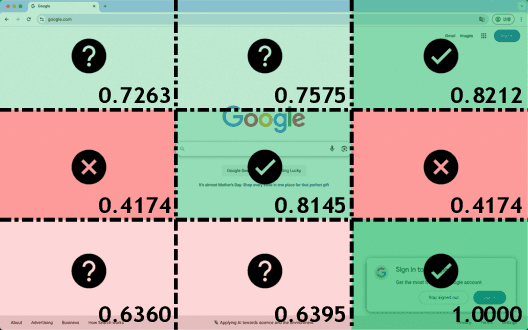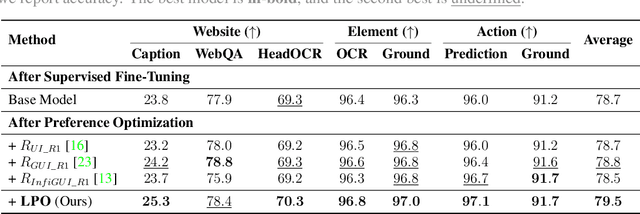Xiaogang Xu
DiffCamera: Arbitrary Refocusing on Images
Sep 30, 2025Abstract:The depth-of-field (DoF) effect, which introduces aesthetically pleasing blur, enhances photographic quality but is fixed and difficult to modify once the image has been created. This becomes problematic when the applied blur is undesirable~(e.g., the subject is out of focus). To address this, we propose DiffCamera, a model that enables flexible refocusing of a created image conditioned on an arbitrary new focus point and a blur level. Specifically, we design a diffusion transformer framework for refocusing learning. However, the training requires pairs of data with different focus planes and bokeh levels in the same scene, which are hard to acquire. To overcome this limitation, we develop a simulation-based pipeline to generate large-scale image pairs with varying focus planes and bokeh levels. With the simulated data, we find that training with only a vanilla diffusion objective often leads to incorrect DoF behaviors due to the complexity of the task. This requires a stronger constraint during training. Inspired by the photographic principle that photos of different focus planes can be linearly blended into a multi-focus image, we propose a stacking constraint during training to enforce precise DoF manipulation. This constraint enhances model training by imposing physically grounded refocusing behavior that the focusing results should be faithfully aligned with the scene structure and the camera conditions so that they can be combined into the correct multi-focus image. We also construct a benchmark to evaluate the effectiveness of our refocusing model. Extensive experiments demonstrate that DiffCamera supports stable refocusing across a wide range of scenes, providing unprecedented control over DoF adjustments for photography and generative AI applications.
Exploiting Unlabeled Structures through Task Consistency Training for Versatile Medical Image Segmentation
Sep 05, 2025



Abstract:Versatile medical image segmentation (VMIS) targets the segmentation of multiple classes, while obtaining full annotations for all classes is often impractical due to the time and labor required. Leveraging partially labeled datasets (PLDs) presents a promising alternative; however, current VMIS approaches face significant class imbalance due to the unequal category distribution in PLDs. Existing methods attempt to address this by generating pseudo-full labels. Nevertheless, these typically require additional models and often result in potential performance degradation from label noise. In this work, we introduce a Task Consistency Training (TCT) framework to address class imbalance without requiring extra models. TCT includes a backbone network with a main segmentation head (MSH) for multi-channel predictions and multiple auxiliary task heads (ATHs) for task-specific predictions. By enforcing a consistency constraint between the MSH and ATH predictions, TCT effectively utilizes unlabeled anatomical structures. To avoid error propagation from low-consistency, potentially noisy data, we propose a filtering strategy to exclude such data. Additionally, we introduce a unified auxiliary uncertainty-weighted loss (UAUWL) to mitigate segmentation quality declines caused by the dominance of specific tasks. Extensive experiments on eight abdominal datasets from diverse clinical sites demonstrate our approach's effectiveness.
Jailbreaking Commercial Black-Box LLMs with Explicitly Harmful Prompts
Aug 14, 2025Abstract:Evaluating jailbreak attacks is challenging when prompts are not overtly harmful or fail to induce harmful outputs. Unfortunately, many existing red-teaming datasets contain such unsuitable prompts. To evaluate attacks accurately, these datasets need to be assessed and cleaned for maliciousness. However, existing malicious content detection methods rely on either manual annotation, which is labor-intensive, or large language models (LLMs), which have inconsistent accuracy in harmful types. To balance accuracy and efficiency, we propose a hybrid evaluation framework named MDH (Malicious content Detection based on LLMs with Human assistance) that combines LLM-based annotation with minimal human oversight, and apply it to dataset cleaning and detection of jailbroken responses. Furthermore, we find that well-crafted developer messages can significantly boost jailbreak success, leading us to propose two new strategies: D-Attack, which leverages context simulation, and DH-CoT, which incorporates hijacked chains of thought. The Codes, datasets, judgements, and detection results will be released in github repository: https://github.com/AlienZhang1996/DH-CoT.
LoViC: Efficient Long Video Generation with Context Compression
Jul 17, 2025



Abstract:Despite recent advances in diffusion transformers (DiTs) for text-to-video generation, scaling to long-duration content remains challenging due to the quadratic complexity of self-attention. While prior efforts -- such as sparse attention and temporally autoregressive models -- offer partial relief, they often compromise temporal coherence or scalability. We introduce LoViC, a DiT-based framework trained on million-scale open-domain videos, designed to produce long, coherent videos through a segment-wise generation process. At the core of our approach is FlexFormer, an expressive autoencoder that jointly compresses video and text into unified latent representations. It supports variable-length inputs with linearly adjustable compression rates, enabled by a single query token design based on the Q-Former architecture. Additionally, by encoding temporal context through position-aware mechanisms, our model seamlessly supports prediction, retradiction, interpolation, and multi-shot generation within a unified paradigm. Extensive experiments across diverse tasks validate the effectiveness and versatility of our approach.
LPO: Towards Accurate GUI Agent Interaction via Location Preference Optimization
Jun 11, 2025



Abstract:The advent of autonomous agents is transforming interactions with Graphical User Interfaces (GUIs) by employing natural language as a powerful intermediary. Despite the predominance of Supervised Fine-Tuning (SFT) methods in current GUI agents for achieving spatial localization, these methods face substantial challenges due to their limited capacity to accurately perceive positional data. Existing strategies, such as reinforcement learning, often fail to assess positional accuracy effectively, thereby restricting their utility. In response, we introduce Location Preference Optimization (LPO), a novel approach that leverages locational data to optimize interaction preferences. LPO uses information entropy to predict interaction positions by focusing on zones rich in information. Besides, it further introduces a dynamic location reward function based on physical distance, reflecting the varying importance of interaction positions. Supported by Group Relative Preference Optimization (GRPO), LPO facilitates an extensive exploration of GUI environments and significantly enhances interaction precision. Comprehensive experiments demonstrate LPO's superior performance, achieving SOTA results across both offline benchmarks and real-world online evaluations. Our code will be made publicly available soon, at https://github.com/AIDC-AI/LPO.
Boosting Diffusion-Based Text Image Super-Resolution Model Towards Generalized Real-World Scenarios
Mar 11, 2025Abstract:Restoring low-resolution text images presents a significant challenge, as it requires maintaining both the fidelity and stylistic realism of the text in restored images. Existing text image restoration methods often fall short in hard situations, as the traditional super-resolution models cannot guarantee clarity, while diffusion-based methods fail to maintain fidelity. In this paper, we introduce a novel framework aimed at improving the generalization ability of diffusion models for text image super-resolution (SR), especially promoting fidelity. First, we propose a progressive data sampling strategy that incorporates diverse image types at different stages of training, stabilizing the convergence and improving the generalization. For the network architecture, we leverage a pre-trained SR prior to provide robust spatial reasoning capabilities, enhancing the model's ability to preserve textual information. Additionally, we employ a cross-attention mechanism to better integrate textual priors. To further reduce errors in textual priors, we utilize confidence scores to dynamically adjust the importance of textual features during training. Extensive experiments on real-world datasets demonstrate that our approach not only produces text images with more realistic visual appearances but also improves the accuracy of text structure.
SEE: See Everything Every Time -- Adaptive Brightness Adjustment for Broad Light Range Images via Events
Feb 28, 2025Abstract:Event cameras, with a high dynamic range exceeding $120dB$, significantly outperform traditional embedded cameras, robustly recording detailed changing information under various lighting conditions, including both low- and high-light situations. However, recent research on utilizing event data has primarily focused on low-light image enhancement, neglecting image enhancement and brightness adjustment across a broader range of lighting conditions, such as normal or high illumination. Based on this, we propose a novel research question: how to employ events to enhance and adaptively adjust the brightness of images captured under broad lighting conditions? To investigate this question, we first collected a new dataset, SEE-600K, consisting of 610,126 images and corresponding events across 202 scenarios, each featuring an average of four lighting conditions with over a 1000-fold variation in illumination. Subsequently, we propose a framework that effectively utilizes events to smoothly adjust image brightness through the use of prompts. Our framework captures color through sensor patterns, uses cross-attention to model events as a brightness dictionary, and adjusts the image's dynamic range to form a broad light-range representation (BLR), which is then decoded at the pixel level based on the brightness prompt. Experimental results demonstrate that our method not only performs well on the low-light enhancement dataset but also shows robust performance on broader light-range image enhancement using the SEE-600K dataset. Additionally, our approach enables pixel-level brightness adjustment, providing flexibility for post-processing and inspiring more imaging applications. The dataset and source code are publicly available at:https://github.com/yunfanLu/SEE.
DiffDoctor: Diagnosing Image Diffusion Models Before Treating
Jan 21, 2025



Abstract:In spite of the recent progress, image diffusion models still produce artifacts. A common solution is to refine an established model with a quality assessment system, which generally rates an image in its entirety. In this work, we believe problem-solving starts with identification, yielding the request that the model should be aware of not just the presence of defects in an image, but their specific locations. Motivated by this, we propose DiffDoctor, a two-stage pipeline to assist image diffusion models in generating fewer artifacts. Concretely, the first stage targets developing a robust artifact detector, for which we collect a dataset of over 1M flawed synthesized images and set up an efficient human-in-the-loop annotation process, incorporating a carefully designed class-balance strategy. The learned artifact detector is then involved in the second stage to tune the diffusion model through assigning a per-pixel confidence map for each synthesis. Extensive experiments on text-to-image diffusion models demonstrate the effectiveness of our artifact detector as well as the soundness of our diagnose-then-treat design.
Generative Visual Commonsense Answering and Explaining with Generative Scene Graph Constructing
Jan 15, 2025Abstract:Visual Commonsense Reasoning, which is regarded as one challenging task to pursue advanced visual scene comprehension, has been used to diagnose the reasoning ability of AI systems. However, reliable reasoning requires a good grasp of the scene's details. Existing work fails to effectively exploit the real-world object relationship information present within the scene, and instead overly relies on knowledge from training memory. Based on these observations, we propose a novel scene-graph-enhanced visual commonsense reasoning generation method named \textit{\textbf{G2}}, which first utilizes the image patches and LLMs to construct a location-free scene graph, and then answer and explain based on the scene graph's information. We also propose automatic scene graph filtering and selection strategies to absorb valuable scene graph information during training. Extensive experiments are conducted on the tasks and datasets of scene graph constructing and visual commonsense answering and explaining, respectively. Experimental results and ablation analysis demonstrate the effectiveness of our proposed framework.
DR-Encoder: Encode Low-rank Gradients with Random Prior for Large Language Models Differentially Privately
Dec 22, 2024



Abstract:The emergence of the Large Language Model (LLM) has shown their superiority in a wide range of disciplines, including language understanding and translation, relational logic reasoning, and even partial differential equations solving. The transformer is the pervasive backbone architecture for the foundation model construction. It is vital to research how to adjust the Transformer architecture to achieve an end-to-end privacy guarantee in LLM fine-tuning. In this paper, we investigate three potential information leakage during a federated fine-tuning procedure for LLM (FedLLM). Based on the potential information leakage, we provide an end-to-end privacy guarantee solution for FedLLM by inserting two-stage randomness. The first stage is to train a gradient auto-encoder with a Gaussian random prior based on the statistical information of the gradients generated by local clients. The second stage is to fine-tune the overall LLM with a differential privacy guarantee by adopting appropriate Gaussian noises. We show the efficiency and accuracy gains of our proposed method with several foundation models and two popular evaluation benchmarks. Furthermore, we present a comprehensive privacy analysis with Gaussian Differential Privacy (GDP) and Renyi Differential Privacy (RDP).
 Add to Chrome
Add to Chrome Add to Firefox
Add to Firefox Add to Edge
Add to Edge